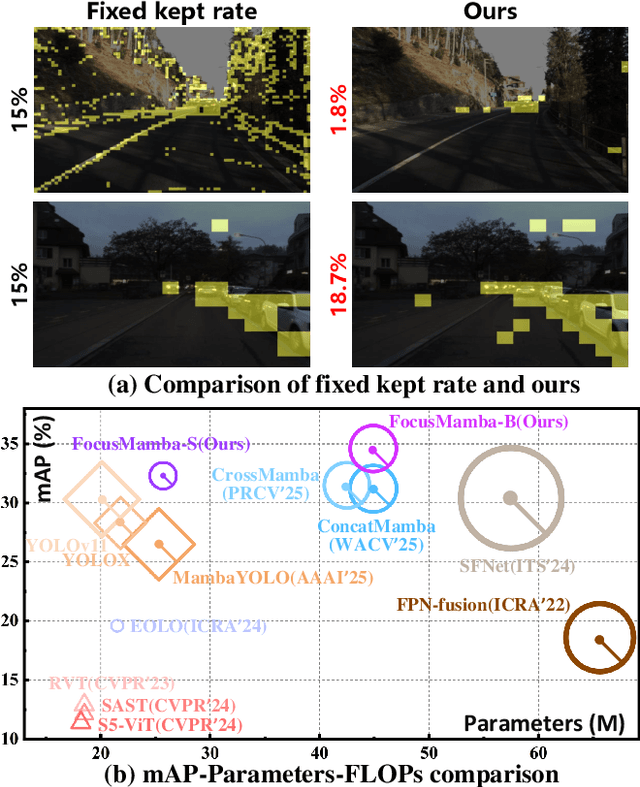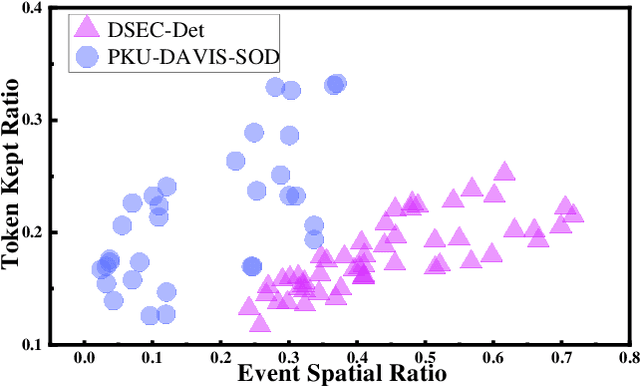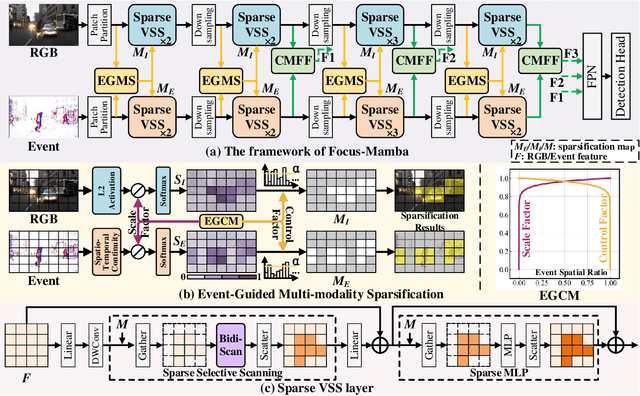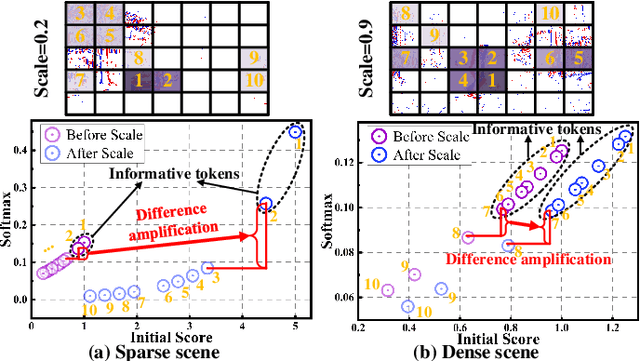Yang Wang
Microsoft Research
MoBiLE: Efficient Mixture-of-Experts Inference on Consumer GPU with Mixture of Big Little Experts
Oct 14, 2025Abstract:Mixture-of-Experts (MoE) models have recently demonstrated exceptional performance across a diverse range of applications. The principle of sparse activation in MoE models facilitates an offloading strategy, wherein active experts are maintained in GPU HBM, while inactive experts are stored in CPU DRAM. The efficacy of this approach, however, is fundamentally constrained by the limited bandwidth of the CPU-GPU interconnect. To mitigate this bottleneck, existing approaches have employed prefetching to accelerate MoE inference. These methods attempt to predict and prefetch the required experts using specially trained modules. Nevertheless, such techniques are often encumbered by significant training overhead and have shown diminished effectiveness on recent MoE models with fine-grained expert segmentation. In this paper, we propose MoBiLE, a plug-and-play offloading-based MoE inference framework with \textit{mixture of big-little experts}. It reduces the number of experts for unimportant tokens to half for acceleration while maintaining full experts for important tokens to guarantee model quality. Further, a dedicated fallback and prefetching mechanism is designed for switching between little and big experts to improve memory efficiency. We evaluate MoBiLE on four typical modern MoE architectures and challenging generative tasks. Our results show that MoBiLE achieves a speedup of 1.60x to 1.72x compared to the baseline on a consumer GPU system, with negligible degradation in accuracy.
Cross-attention Secretly Performs Orthogonal Alignment in Recommendation Models
Oct 10, 2025Abstract:Cross-domain sequential recommendation (CDSR) aims to align heterogeneous user behavior sequences collected from different domains. While cross-attention is widely used to enhance alignment and improve recommendation performance, its underlying mechanism is not fully understood. Most researchers interpret cross-attention as residual alignment, where the output is generated by removing redundant and preserving non-redundant information from the query input by referencing another domain data which is input key and value. Beyond the prevailing view, we introduce Orthogonal Alignment, a phenomenon in which cross-attention discovers novel information that is not present in the query input, and further argue that those two contrasting alignment mechanisms can co-exist in recommendation models We find that when the query input and output of cross-attention are orthogonal, model performance improves over 300 experiments. Notably, Orthogonal Alignment emerges naturally, without any explicit orthogonality constraints. Our key insight is that Orthogonal Alignment emerges naturally because it improves scaling law. We show that baselines additionally incorporating cross-attention module outperform parameter-matched baselines, achieving a superior accuracy-per-model parameter. We hope these findings offer new directions for parameter-efficient scaling in multi-modal research.
Augur: Modeling Covariate Causal Associations in Time Series via Large Language Models
Oct 09, 2025Abstract:Large language models (LLM) have emerged as a promising avenue for time series forecasting, offering the potential to integrate multimodal data. However, existing LLM-based approaches face notable limitations-such as marginalized role in model architectures, reliance on coarse statistical text prompts, and lack of interpretability. In this work, we introduce Augur, a fully LLM driven time series forecasting framework that exploits LLM causal reasoning to discover and use directed causal associations among covariates. Augur uses a two stage teacher student architecture where a powerful teacher LLM infers a directed causal graph from time series using heuristic search together with pairwise causality testing. A lightweight student agent then refines the graph and fine tune on high confidence causal associations that are encoded as rich textual prompts to perform forecasting. This design improves predictive accuracy while yielding transparent, traceable reasoning about variable interactions. Extensive experiments on real-world datasets with 25 baselines demonstrate that Augur achieves competitive performance and robust zero-shot generalization.
MOSS-Speech: Towards True Speech-to-Speech Models Without Text Guidance
Oct 02, 2025Abstract:Spoken dialogue systems often rely on cascaded pipelines that transcribe, process, and resynthesize speech. While effective, this design discards paralinguistic cues and limits expressivity. Recent end-to-end methods reduce latency and better preserve these cues, yet still rely on text intermediates, creating a fundamental bottleneck. We present MOSS-Speech, a true speech-to-speech large language model that directly understands and generates speech without relying on text guidance. Our approach combines a modality-based layer-splitting architecture with a frozen pre-training strategy, preserving the reasoning and knowledge of pretrained text LLMs while adding native speech capabilities. Experiments show that our model achieves state-of-the-art results in spoken question answering and delivers comparable speech-to-speech performance relative to existing text-guided systems, while still maintaining competitive text performance. By narrowing the gap between text-guided and direct speech generation, our work establishes a new paradigm for expressive and efficient end-to-end speech interaction.
MG2FlowNet: Accelerating High-Reward Sample Generation via Enhanced MCTS and Greediness Control
Oct 01, 2025Abstract:Generative Flow Networks (GFlowNets) have emerged as a powerful tool for generating diverse and high-reward structured objects by learning to sample from a distribution proportional to a given reward function. Unlike conventional reinforcement learning (RL) approaches that prioritize optimization of a single trajectory, GFlowNets seek to balance diversity and reward by modeling the entire trajectory distribution. This capability makes them especially suitable for domains such as molecular design and combinatorial optimization. However, existing GFlowNets sampling strategies tend to overexplore and struggle to consistently generate high-reward samples, particularly in large search spaces with sparse high-reward regions. Therefore, improving the probability of generating high-reward samples without sacrificing diversity remains a key challenge under this premise. In this work, we integrate an enhanced Monte Carlo Tree Search (MCTS) into the GFlowNets sampling process, using MCTS-based policy evaluation to guide the generation toward high-reward trajectories and Polynomial Upper Confidence Trees (PUCT) to balance exploration and exploitation adaptively, and we introduce a controllable mechanism to regulate the degree of greediness. Our method enhances exploitation without sacrificing diversity by dynamically balancing exploration and reward-driven guidance. The experimental results show that our method can not only accelerate the speed of discovering high-reward regions but also continuously generate high-reward samples, while preserving the diversity of the generative distribution. All implementations are available at https://github.com/ZRNB/MG2FlowNet.
EMMA: Generalizing Real-World Robot Manipulation via Generative Visual Transfer
Sep 26, 2025Abstract:Vision-language-action (VLA) models increasingly rely on diverse training data to achieve robust generalization. However, collecting large-scale real-world robot manipulation data across varied object appearances and environmental conditions remains prohibitively time-consuming and expensive. To overcome this bottleneck, we propose Embodied Manipulation Media Adaptation (EMMA), a VLA policy enhancement framework that integrates a generative data engine with an effective training pipeline. We introduce DreamTransfer, a diffusion Transformer-based framework for generating multi-view consistent, geometrically grounded embodied manipulation videos. DreamTransfer enables text-controlled visual editing of robot videos, transforming foreground, background, and lighting conditions without compromising 3D structure or geometrical plausibility. Furthermore, we explore hybrid training with real and generated data, and introduce AdaMix, a hard-sample-aware training strategy that dynamically reweights training batches to focus optimization on perceptually or kinematically challenging samples. Extensive experiments show that videos generated by DreamTransfer significantly outperform prior video generation methods in multi-view consistency, geometric fidelity, and text-conditioning accuracy. Crucially, VLAs trained with generated data enable robots to generalize to unseen object categories and novel visual domains using only demonstrations from a single appearance. In real-world robotic manipulation tasks with zero-shot visual domains, our approach achieves over a 200% relative performance gain compared to training on real data alone, and further improves by 13% with AdaMix, demonstrating its effectiveness in boosting policy generalization.
PSTTS: A Plug-and-Play Token Selector for Efficient Event-based Spatio-temporal Representation Learning
Sep 26, 2025Abstract:Mainstream event-based spatio-temporal representation learning methods typically process event streams by converting them into sequences of event frames, achieving remarkable performance. However, they neglect the high spatial sparsity and inter-frame motion redundancy inherent in event frame sequences, leading to significant computational overhead. Existing token sparsification methods for RGB videos rely on unreliable intermediate token representations and neglect the influence of event noise, making them ineffective for direct application to event data. In this paper, we propose Progressive Spatio-Temporal Token Selection (PSTTS), a Plug-and-Play module for event data without introducing any additional parameters. PSTTS exploits the spatio-temporal distribution characteristics embedded in raw event data to effectively identify and discard spatio-temporal redundant tokens, achieving an optimal trade-off between accuracy and efficiency. Specifically, PSTTS consists of two stages, Spatial Token Purification and Temporal Token Selection. Spatial Token Purification discards noise and non-event regions by assessing the spatio-temporal consistency of events within each event frame to prevent interference with subsequent temporal redundancy evaluation. Temporal Token Selection evaluates the motion pattern similarity between adjacent event frames, precisely identifying and removing redundant temporal information. We apply PSTTS to four representative backbones UniformerV2, VideoSwin, EVMamba, and ExACT on the HARDVS, DailyDVS-200, and SeACT datasets. Experimental results demonstrate that PSTTS achieves significant efficiency improvements. Specifically, PSTTS reduces FLOPs by 29-43.6% and increases FPS by 21.6-41.3% on the DailyDVS-200 dataset, while maintaining task accuracy. Our code will be available.
Harnessing Uncertainty: Entropy-Modulated Policy Gradients for Long-Horizon LLM Agents
Sep 11, 2025Abstract:In long-horizon tasks, recent agents based on Large Language Models (LLMs) face a significant challenge that sparse, outcome-based rewards make it difficult to assign credit to intermediate steps. Previous methods mainly focus on creating dense reward signals to guide learning, either through traditional reinforcement learning techniques like inverse reinforcement learning or by using Process Reward Models for step-by-step feedback. In this paper, we identify a fundamental problem in the learning dynamics of LLMs: the magnitude of policy gradients is inherently coupled with the entropy, which leads to inefficient small updates for confident correct actions and potentially destabilizes large updates for uncertain ones. To resolve this, we propose Entropy-Modulated Policy Gradients (EMPG), a framework that re-calibrates the learning signal based on step-wise uncertainty and the final task outcome. EMPG amplifies updates for confident correct actions, penalizes confident errors, and attenuates updates from uncertain steps to stabilize exploration. We further introduce a bonus term for future clarity that encourages agents to find more predictable solution paths. Through comprehensive experiments on three challenging agent tasks, WebShop, ALFWorld, and Deep Search, we demonstrate that EMPG achieves substantial performance gains and significantly outperforms strong policy gradient baselines. Project page is at https://empgseed-seed.github.io/
Drivel-ology: Challenging LLMs with Interpreting Nonsense with Depth
Sep 04, 2025



Abstract:We introduce Drivelology, a unique linguistic phenomenon characterised as "nonsense with depth", utterances that are syntactically coherent yet pragmatically paradoxical, emotionally loaded, or rhetorically subversive. While such expressions may resemble surface-level nonsense, they encode implicit meaning requiring contextual inference, moral reasoning, or emotional interpretation. We find that current large language models (LLMs), despite excelling at many natural language processing (NLP) tasks, consistently fail to grasp the layered semantics of Drivelological text. To investigate this, we construct a small but diverse benchmark dataset of over 1,200 meticulously curated examples, with select instances in English, Mandarin, Spanish, French, Japanese, and Korean. Annotation was especially challenging: each of the examples required careful expert review to verify that it truly reflected Drivelological characteristics. The process involved multiple rounds of discussion and adjudication to address disagreements, highlighting the subtle and subjective nature of the Drivelology. We evaluate a range of LLMs on classification, generation, and reasoning tasks. Our results reveal clear limitations of LLMs: models often confuse Drivelology with shallow nonsense, produce incoherent justifications, or miss the implied rhetorical function altogether. These findings highlight a deeper representational gap in LLMs' pragmatic understanding and challenge the assumption that statistical fluency implies cognitive comprehension. We release our dataset and code to facilitate further research in modelling linguistic depth beyond surface-level coherence.
Focus Through Motion: RGB-Event Collaborative Token Sparsification for Efficient Object Detection
Sep 04, 2025



Abstract:Existing RGB-Event detection methods process the low-information regions of both modalities (background in images and non-event regions in event data) uniformly during feature extraction and fusion, resulting in high computational costs and suboptimal performance. To mitigate the computational redundancy during feature extraction, researchers have respectively proposed token sparsification methods for the image and event modalities. However, these methods employ a fixed number or threshold for token selection, hindering the retention of informative tokens for samples with varying complexity. To achieve a better balance between accuracy and efficiency, we propose FocusMamba, which performs adaptive collaborative sparsification of multimodal features and efficiently integrates complementary information. Specifically, an Event-Guided Multimodal Sparsification (EGMS) strategy is designed to identify and adaptively discard low-information regions within each modality by leveraging scene content changes perceived by the event camera. Based on the sparsification results, a Cross-Modality Focus Fusion (CMFF) module is proposed to effectively capture and integrate complementary features from both modalities. Experiments on the DSEC-Det and PKU-DAVIS-SOD datasets demonstrate that the proposed method achieves superior performance in both accuracy and efficiency compared to existing methods. The code will be available at https://github.com/Zizzzzzzz/FocusMamba.
 Add to Chrome
Add to Chrome Add to Firefox
Add to Firefox Add to Edge
Add to Edge